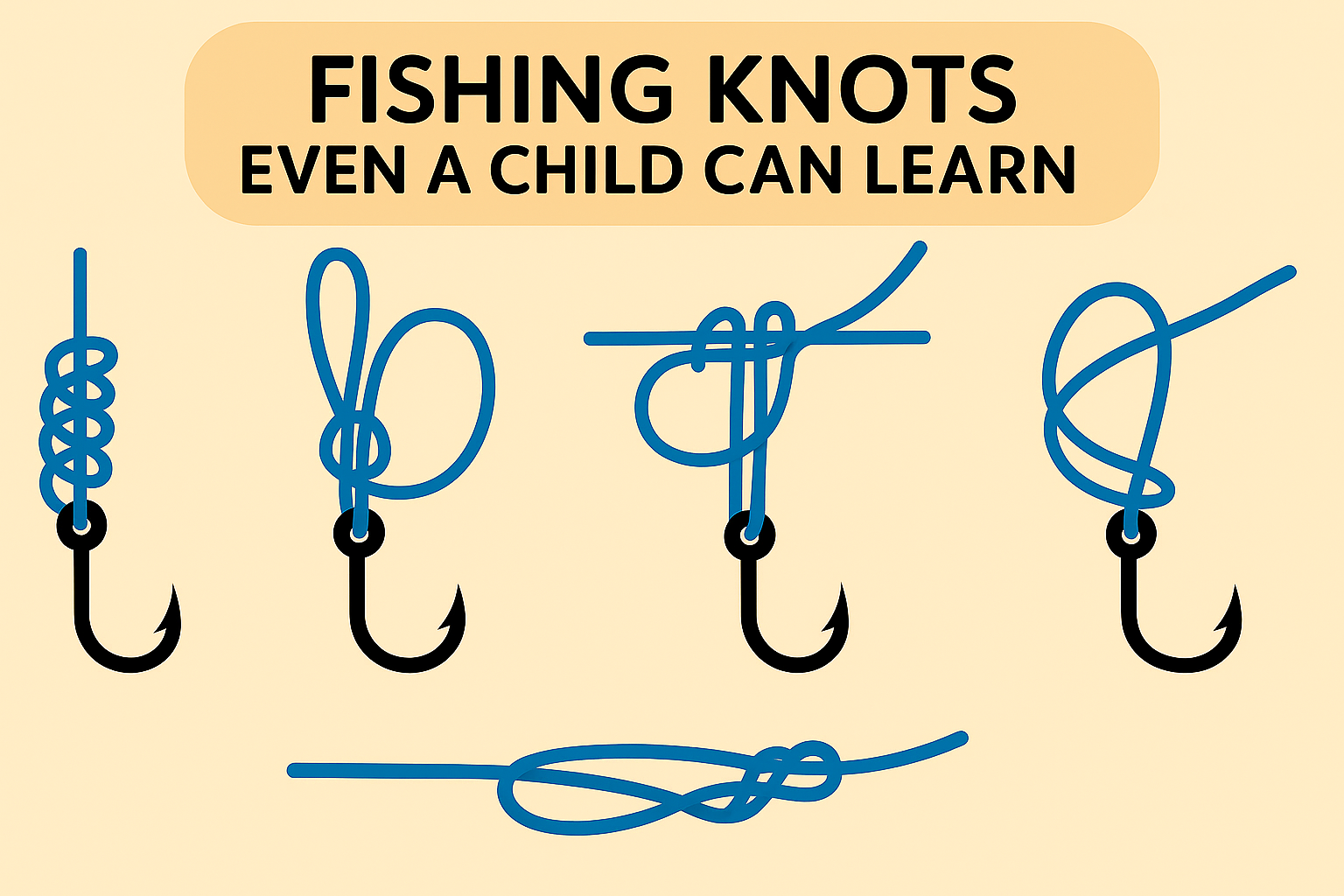In This Post
Key Takeaways
- Basic fishing knots like the Improved Clinch Knot and Palomar Knot make excellent starting points for children learning to fish
- Teaching kids to tie fishing knots builds independence, confidence, and fine motor skills
- Beginning with thicker rope and using color-coded visual aids makes learning knots significantly easier for young children
- Effective teaching strategies can turn potentially frustrating knot lessons into enjoyable fishing experiences
5 Easiest Fishing Knots Perfect for Little Hands
Teaching kids to fish takes patience, but with straightforward techniques, even young children can learn essential fishing skills. Simple knots create the difference between frustration and a fun day on the water.
We know that starting with basic knots builds a foundation for fishing success that lasts a lifetime.
Why Teaching Kids Fishing Knots Matters
Many parents skip knot-tying lessons with children, thinking it’s too complicated. However, teaching kids to tie their own fishing knots creates independence, confidence, and a stronger connection to the sport.
When a child catches a fish using a knot they tied themselves, their pride is unmistakable.
Knot-tying also develops fine motor skills and patience—valuable abilities that help in many areas beyond fishing.
With good guidance and simple techniques, children as young as five can start learning basic knots that will help them throughout their fishing years.
The Super-Simple Starter Knots
1. Improved Clinch Knot: The First Knot Every Child Should Master
The Improved Clinch Knot works perfectly as an introduction to fishing knots. This practical knot secures hooks, lures, and swivels to the fishing line with great strength despite being very simple.
For children, the process breaks down into three easy steps:
- Thread the line through the hook eye
- Wrap the line around itself 5-7 times
- Thread the end back through the first loop and pull tight
Children can see their progress clearly with each wrap, making it easier to spot and fix mistakes before they become frustrating tangles.
2. Palomar Knot: Strongest and Simplest
Though one of the strongest fishing knots available, the Palomar Knot remains remarkably simple—perfect for children’s small hands. Its combination of strength and simplicity makes it great for kids who might struggle with more complex movements.
The Palomar follows four easy steps:
- Double about 6 inches of line and pass it through the hook eye
- Tie a simple overhand knot with the doubled line, keeping the hook hanging loose
- Pass the hook through the loop end of the knot
- Pull both ends to tighten, moistening the line first for smooth tightening
Children like this knot because it’s nearly impossible to tie incorrectly, building confidence with each successful attempt.
3. Surgeon’s Knot: Connect Two Lines Easily
When children need to connect two fishing lines of different thicknesses, the Surgeon’s Knot offers a simple solution. This knot just requires aligning two lines and tying a basic overhand knot—twice.
The Surgeon’s Knot feels intuitive—most children already know how to tie a basic knot in their shoelaces, making this a natural extension of skills they already have.
It also forgives small mistakes in technique, making it great for beginners who might not pull it perfectly tight.
4. Overhand Loop: Create Lure Attachment Points
The Overhand Loop provides perhaps the simplest starting point for knot tying for the youngest anglers. By folding line back on itself and tying a simple overhand knot, children can create a loop that works for attaching various lures and tackle.
This basic knot teaches concepts like ‘working end’ and ‘standing line’ without overwhelming new anglers. Many fishing teachers start here before moving to more specific knots, especially with children under seven years old.
5. Arbor Knot: Perfect for Spooling Reels
The Arbor Knot addresses the specific task of attaching fishing line to a reel spool. For children learning to set up their own equipment, this simple knot creates a sense of accomplishment and ownership of their gear.
Made of a simple overhand knot followed by another overhand knot for security, the Arbor Knot takes just minutes to learn. Children enjoy this knot because it marks the first step in preparing their very own fishing rod.
Foolproof Teaching Methods
1. Start with Thicker Rope
Before using thin, slippery fishing line, begin knot-tying lessons with colorful paracord or thick yarn. The larger size makes knot formation clearly visible and easier for small fingers to handle.
This method builds confidence and muscle memory before moving to actual fishing line.
An inch-thick rope works best as a starting point, allowing children to clearly see how loops form and connect with each other.
2. Use Visual Color-Coding
Try using two different colored ropes or marking sections of a single rope with colorful tape. This visual help allows children to track the working end of the line through complicated moves.
When instructions say ‘pass the end through the loop,’ the color difference shows clearly which part is which.
For instance, using a blue rope with a red-marked end helps children follow instructions like “the red end goes around the blue part twice.”
3. Create Memorable Rhymes
Knot-tying steps stick better with simple rhymes or sayings. For example, children might remember the Improved Clinch as ‘Through the eye, around and by, back through the loop, pull it tight—don’t be shy!’
These verbal reminders help during moments of confusion.
4. Practice in Non-Fishing Settings
Fishing trips aren’t always the best places for learning new skills. Instead, practice knot-tying during quiet times at home, perhaps while watching fishing shows or before bedtime.
Without the pressure of catching fish, children can focus completely on learning the movements.
5. Turn Learning into Games
Make knot practice into a friendly competition with timed challenges or accuracy tests.
Try a ‘knot relay race’ where teams compete to tie a specific knot correctly, or create a ‘knot scavenger hunt’ with clues leading to different knot-tying stations around the yard.
Making practice fun reduces frustration and keeps children engaged during learning.
When to Use Each Knot
Hook Attachment
For attaching hooks and most lures, the Improved Clinch Knot and Palomar Knot offer the best mix of simplicity and strength.
Children should learn both but may prefer whichever feels more natural to their hands. The Improved Clinch works well for lighter tackle, while the Palomar gives additional strength for larger fish.
A simple rule for kids: if the fish are small (like bluegill or small trout), the Improved Clinch works perfectly. For bigger fish that pull harder, the Palomar gives extra security.
Line-to-Line Connection
When connecting lines of similar or different diameters—such as attaching a leader to the main line—the Surgeon’s Knot offers the most straightforward solution.
Its flexible structure allows for extra turns when connecting lines of different thicknesses, making it useful for various fishing situations.
Children particularly like how this knot resembles tying a double knot in their shoelaces, making it easy to remember even after long breaks between fishing trips.
Line-to-Lure Ties
While many lures can be attached using the same knots as hooks, certain specialty lures need loop knots that allow for more natural movement in the water.
The Overhand Loop gives enough freedom of movement for most children’s fishing needs while remaining easy to tie and see.
This knot works especially well with lures that need to ‘swim’ naturally, like small crankbaits that often come in children’s fishing kits.
Reel Attachment
The Arbor Knot stands as the clear choice for attaching line to the reel spool. Its security with minimal complexity makes it perfect for young anglers learning to set up their own equipment.
This knot also teaches an important lesson: sometimes the simplest approach works best.
Children who master the Arbor Knot gain independence in setting up their own fishing rod—an important milestone in their fishing development.
Troubleshooting Kid-Sized Challenges
1. Dealing with Frustration and Tangles
When knots inevitably go wrong, use these moments as teaching opportunities rather than sources of frustration. Keep scissors handy to cut away truly hopeless tangles, and remember that each failed attempt teaches valuable lessons.
Ask children to describe what went wrong—’The line twisted’ or ‘I pulled the wrong end’—to build problem-solving skills.
The ‘pause and reset’ method works well: when frustration builds, take a 30-second break to examine what went wrong before trying again with a fresh perspective.
2. Adapting Techniques for Small Fingers
Children with smaller hands may find certain knot-tying movements difficult.
Try different approaches such as wrapping the line around a pencil instead of directly with fingers, or using clothespins to hold parts of the knot temporarily in place.
These adjustments maintain the knot’s function while working with developmental limitations.
For very young children, pre-tying most knots but letting them complete the final pull can build confidence while they develop dexterity for more complex movements.
3. When to Step In and Help
While independence matters, recognize when frustration might ruin the learning experience.
A practical rule: offer help after three unsuccessful attempts, but provide only enough assistance to overcome the specific challenge before giving control back to the child. This balanced approach maintains confidence while building skills.
The goal should be gradual independence—each fishing trip should need less help than the last as children master these essential skills.
Fishing Success Starts With Knot Knowledge
Fishing knots are more than just technical skills—they represent the tradition and craft of fishing.
As children learn these fundamental connections between angler and fish, they gain practical abilities plus confidence, patience, and problem-solving skills that help them in many areas of life.
Perfect knots aren’t the goal; what matters is the learning process, the happiness of success, and the resilience built through challenges.
With these five simple knots and thoughtful teaching methods, you’ll give young anglers basic skills that last a lifetime on the water.







